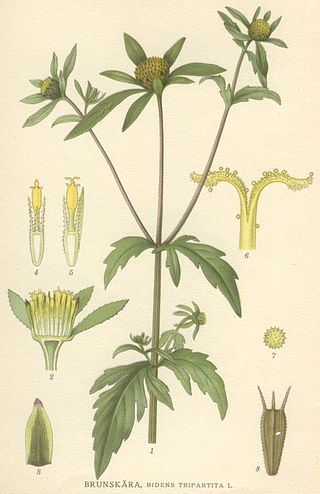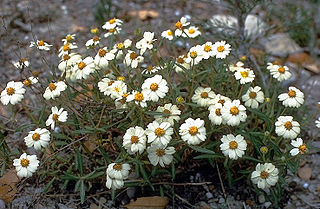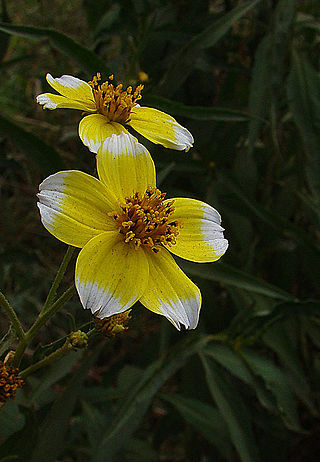
Cosmos is a genus, with the same common name of cosmos, consisting of flowering plants in the sunflower family.

Bidens is a genus of flowering plants in the aster family, Asteraceae. The genus include roughly 230 species which are distributed worldwide. Despite their global distribution, the systematics and taxonomy of the genus has been described as complicated and unorganized. The common names beggarticks, black jack, burr marigolds, cobbler's pegs, Spanish needles, stickseeds, tickseeds and tickseed sunflowers refer to the fruits of the plants, most of which are bristly and barbed. The generic name refers to the same character; Bidens comes from the Latin bis ("two") and dens ("tooth").

Melampodium is a genus of flowering plants in the sunflower family.

A botanical name is a formal scientific name conforming to the International Code of Nomenclature for algae, fungi, and plants (ICN) and, if it concerns a plant cultigen, the additional cultivar or Group epithets must conform to the International Code of Nomenclature for Cultivated Plants (ICNCP). The code of nomenclature covers "all organisms traditionally treated as algae, fungi, or plants, whether fossil or non-fossil, including blue-green algae (Cyanobacteria), chytrids, oomycetes, slime moulds and photosynthetic protists with their taxonomically related non-photosynthetic groups ."
In botany, an infraspecific name is the scientific name for any taxon below the rank of species, i.e. an infraspecific taxon or infraspecies. The scientific names of botanical taxa are regulated by the International Code of Nomenclature for algae, fungi, and plants (ICN). As specified by the ICN, the name of an infraspecific taxon is a combination of the name of a species and an infraspecific epithet, separated by a connecting term that denotes the rank of the taxon. An example of an infraspecific name is Astrophytum myriostigma subvar. glabrum, the name of a subvariety of the species Astrophytum myriostigma. In the previous example, glabrum is the infraspecific epithet.
In botanical nomenclature, autonyms are automatically created names, as regulated by the International Code of Nomenclature for algae, fungi, and plants that are created for certain subdivisions of genera and species, those that include the type of the genus or species. An autonym might not be mentioned in the publication that creates it as a side-effect. Autonyms "repeat unaltered" the genus name or species epithet of the taxon being subdivided, and no other name for that same subdivision is validly published. For example, Rubus subgenus Eubatus is not validly published, and the subgenus is known as Rubus subgen. Rubus.

Sarracenia rosea is a species of pitcher plant in the genus Sarracenia and is sometimes known as Burk's southern pitcher plant.

Thelesperma is a genus of North American and South American plants in the cosmos tribe within the sunflower family. Greenthread is a common name for plants in this genus.

Cosmos parviflorus, commonly known as the southwestern cosmos, is an annual, herbaceous, flowering plant in the Asteraceae family. It is native to parts of the Southwestern United States and most of Mexico and appears to be introduced in portions of the Northeastern United States.

Calochortus venustulus is a Mexican species of plants in the lily family native to central and eastern Mexico and bearing yellow flowers. Two varieties are recognized.

Bidens aurea , the Arizona beggarticks, is a North American species of flowering plant in the family Asteraceae. It is widespread across much of Mexico and found also in Arizona and Guatemala. The species is also naturalized in parts of Europe and South America.
Bidens leptocephala, commonly known as the fewflower beggarticks, is an annual herbaceous flowering plant in the Asteraceae family. It is native to the southwestern United States and northern Mexico.
Carminatia recondita is a Mesoamerican species of annual plants in the family Asteraceae.

Coreocarpus arizonicus, the little lemonhead, is a North American species of flowering plants in the daisy family native to northwestern Mexico and the southwestern United States. It has been found in southern Arizona, and in the adjacent Mexican States of Sonora, Chihuahua, Sinaloa, and Baja California Sur.

Coreopsis intermedia, the goldenwave tickseed, is a North American species of plants in the family Asteraceae. It is native to a small region in the south-central United States (eastern Texas, western Louisiana, southwestern Arkansas.

Cosmos ochroleucoflorus is a Mexican species of plants in the family Asteraceae. It has been found only in the state of Durango in northwestern Mexico.
Cosmos sherffii is a Mexican species of plants in the family Asteraceae. It has been found only in the state of Oaxaca in southern Mexico.
Cosmos longipetiolatus is a Mexican species of plants in the family Asteraceae. It has been found only in the state of Jalisco in southern Mexico.
Hymenoxys brandegeei is a species of flowering plant in the daisy family known by the common names Brandegee's four-nerve daisy, Brandegee's rubberweed or western bitterweed. It is native to the states of Arizona, Colorado, and New Mexico in the southwestern United States.

Guizotia jacksonii is a low, creeping, perennial plant with ovate leaves and yellow flowerheads belonging to the family Asteraceae. This species is endemic to Kenya, and grows along roads and other open places in the forest zones the central highlands of Kenya.












